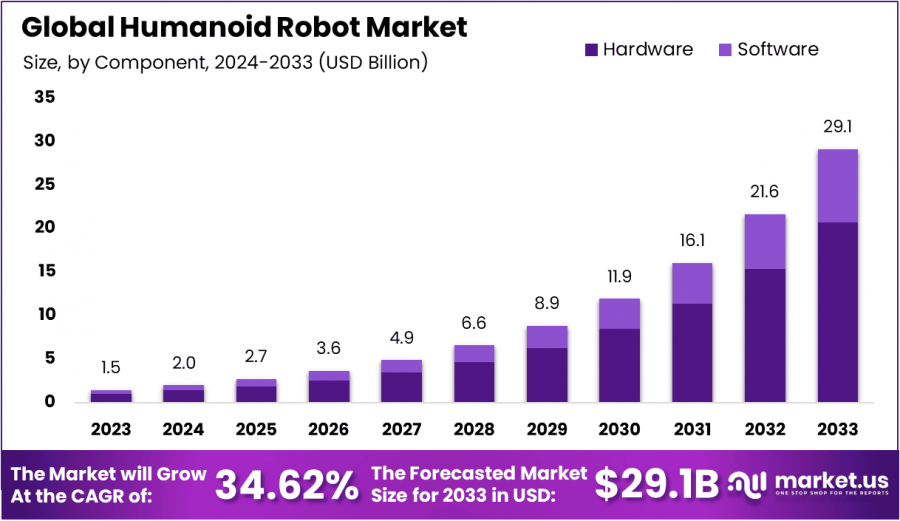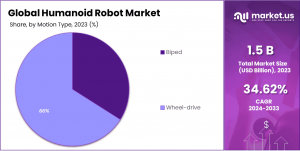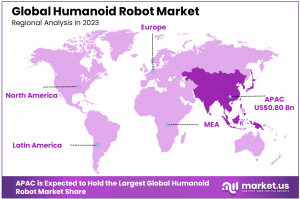
Humanoid Robot Market to Grow to USD 29.12 Bn by 2033, Hardware Segment Leads with 71%
The Global Humanoid Robot Market is forecasted to grow from USD 2.0 billion in 2024 to USD 29.12 billion by 2033, registering a staggering 62% CAGR (2024-2033)
NEW YORK, NY, UNITED STATES, January 27, 2025 /EINPresswire.com/ -- As reported by Market.us, The surge in the humanoid robot market is primarily driven by the increasing demand for robots that offer flexibility and enhanced visibility in industrial operations. Additionally, there's a rising need for humanoid robots in logistics and medical sectors, where they can perform complex tasks with precision and efficiency. The emergence of smart manufacturing and the growing geriatric population in developed countries also contribute significantly to the market's growth, as these robots are increasingly used for personal assistance and caregiving.
Humanoid robots are becoming more prevalent in education, entertainment, and public relations, where they serve as interactive agents that can engage with humans in a variety of contexts. Innovations in hardware and software components of these robots have enabled them to perform more sophisticated tasks, making them valuable tools in research and space exploration, as well as in search and rescue operations.
Investors and companies in the humanoid robot market stand to benefit from the sector's robust growth through potential high returns on investments as the market expands. Stakeholders are particularly looking at gains from the deployment of humanoid robots in manufacturing, healthcare, and service industries where their ability to interact and assist humans is highly valued. The detailed market analyses and forecasts provide stakeholders with insights necessary to make informed decisions and strategize effectively to capitalize on market opportunities.
👉 𝐒𝐚𝐦𝐩𝐥𝐞 𝐑𝐞𝐩𝐨𝐫𝐭 𝐑𝐞𝐪𝐮𝐞𝐬𝐭: 𝐔𝐧𝐥𝐨𝐜𝐤 𝐕𝐚𝐥𝐮𝐚𝐛𝐥𝐞 𝐈𝐧𝐬𝐢𝐠𝐡𝐭𝐬 𝐟𝐨𝐫 𝐘𝐨𝐮𝐫 𝐁𝐮𝐬𝐢𝐧𝐞𝐬𝐬: https://market.us/report/humanoid-robot-market/request-sample/
For instance, In February 2024, Figure AI, a robotics startup, secured $675 million in funding from major investors like Nvidia, Jeff Bezos, OpenAI, and Microsoft. This significant investment highlights the growing interest in humanoid robots, not just for industrial tasks but also for advancing fields like neuroscience and behavioral science. These robots have potential beyond physical tasks—they can aid in studying human cognition, participation, and behavior, bridging technology and human understanding.
Humanoid Robot Market Insights
➤The global humanoid robot market is poised for remarkable growth, projected to reach a value of USD 29.12 billion by 2033, up from USD 1.49 billion in 2023. This represents a staggering compound annual growth rate (CAGR) of 62% between 2024 and 2033.
➤In 2023, the hardware segment emerged as the market leader, accounting for more than 71% of the market share. This dominance is driven by advancements in robotic components such as sensors, actuators, and control systems, which are crucial for humanoid functionality.
➤The wheel-drive segment also captured a significant share of the market in 2023, contributing over 66% of total revenue. The preference for wheel-driven robots is attributed to their stability, efficiency, and widespread adoption in various industries.
➤Humanoid robots designed for personal assistance and caregiving gained traction in 2023, securing more than 32.5% of the market share. These robots are increasingly used in elderly care, household tasks, and healthcare applications, reflecting a growing societal need for reliable caregiving solutions.
👉 𝐁𝐮𝐲 𝐍𝐨𝐰 𝐭𝐡𝐢𝐬 𝐏𝐫𝐞𝐦𝐢𝐮𝐦 𝐑𝐞𝐩𝐨𝐫𝐭 𝐭𝐨 𝐆𝐫𝐨𝐰 𝐲𝐨𝐮𝐫 𝐁𝐮𝐬𝐢𝐧𝐞𝐬𝐬: https://market.us/purchase-report/?report_id=125475
Impact of AI on Humanoid Robot Market
The impact of artificial intelligence (AI) on the humanoid robot market is profound and multifaceted, driving significant advancements and market growth. AI technologies enable humanoid robots to perform complex tasks more efficiently and with greater autonomy. Here’s a detailed look at how AI is influencing the market:
Enhancing Capabilities AI contributes to the sophistication of humanoid robots, enhancing their learning algorithms and enabling them to understand and interpret human emotions and actions better. This allows robots to perform tasks more effectively in personal assistance, caregiving, and customer service roles.
Expanding Applications With AI, humanoid robots can be used in more varied applications. For instance, they are increasingly utilized in healthcare for patient care and in retail environments to interact with customers. AI enables these robots to handle tasks that require adaptive responses, making them more versatile and valuable across different sectors.
Improving Interactions AI improves the interaction between humans and robots by enabling more natural communication. Through natural language processing and machine learning, humanoid robots can engage in conversations, recognize speech patterns, and respond appropriately, enhancing their usability in education, entertainment, and public relations.
Operational Efficiency In industrial and logistical applications, AI-driven humanoid robots can optimize operations, reduce costs, and increase efficiency. They can autonomously navigate complex environments and perform repetitive tasks, reducing human error and enhancing productivity.
Recent Developments
In April 2024, Boston Dynamics launched its groundbreaking electric Atlas humanoid robot, marking a significant leap from its earlier hydraulic model. This shift to electric technology aims to enhance efficiency, precision, and sustainability in the robotics industry, positioning Atlas as a key player in next-generation automation.
Meanwhile, in February 2024, Kepler Exploration Robot Co., Ltd. unveiled the Kepler Forerunner series, a new line of general-purpose humanoid robots. These robots stand 178 cm (5'10") tall, weigh 85 kg (187 lbs.), and feature advanced, highly dexterous hands with 12 degrees of freedom, enabling intricate and precise movements. With these innovations, Kepler is setting its sights on versatile applications, from manufacturing to service industries.
In December 2024, Samsung announced plans to increase its ownership in Rainbow Robotics to 35%, exercising a call option to make the robotics company its subsidiary. This strategic move highlights Samsung's commitment to advancing humanoid robot technology. Founded in 2011, Rainbow Robotics is renowned for its innovation, including Korea's first two-legged walking robot, "Hubo." The partnership signals Samsung’s push to dominate the robotics space with cutting-edge solutions.
In November 2024, ROBOTIS partnered with MIT to co-develop "Physical AI"—an advanced robotics technology that integrates reflexive AI with precision sensing systems to enhance human-like physical intelligence. Supported by KIAT and the Ministry of Trade, Industry, and Energy, this collaboration will focus on improving OpenMANIPULATOR-Y (OM-Y), a collaborative robot by ROBOTIS. The goal is to increase its efficiency across diverse industries, signaling a leap in precision robotics.
In the same month, Agility Robotics secured a minority investment from Schaeffler Group and agreed to supply Schaeffler with its bipedal robot, Digit, for deployment across global manufacturing plants. This partnership highlights the growing trend of integrating humanoid robotics, like Digit, to streamline operations and boost automation in manufacturing processes.
👉 𝐁𝐮𝐢𝐥𝐝 𝐚 𝐅𝐮𝐭𝐮𝐫𝐞 - 𝐩𝐫𝐨𝐨𝐟 𝐁𝐮𝐬𝐢𝐧𝐞𝐬𝐬! 𝐁𝐮𝐲 𝐨𝐮𝐫 𝐏𝐫𝐞𝐦𝐢𝐮𝐦 𝐈𝐧𝐬𝐢𝐠𝐡𝐭𝐬 𝐚𝐭 𝐀𝐟𝐟𝐨𝐫𝐝𝐚𝐛𝐥𝐞 𝐏𝐫𝐢𝐜𝐞𝐬 𝐍𝐨𝐰: https://market.us/purchase-report/?report_id=125475
Report Segmentation
Component Segment Analysis
The Hardware segment has asserted itself as a cornerstone of the Humanoid Robot Market. In 2023, this segment achieved a commanding presence, securing a 71% market share. This dominance is attributed to the critical role that hardware plays in the functionality and efficiency of humanoid robots. Key components such as sensors, actuators, and control systems form the backbone of these robots, enabling them to perform complex tasks with precision. The ongoing advancements in robotics hardware, driven by increasing investments in R&D, continue to enhance the capabilities of humanoid robots, thereby fueling the growth of this segment.
Motion Type Segment Analysis
Another pivotal aspect of the Humanoid Robot Market is the Motion Type segment, where the Wheel-drive category has taken a leading position. In 2023, it captured a significant 66% of the market share. This preference for wheel-driven robots highlights their versatility and reliability in various applications, from industrial automation to customer service. The wheel-drive technology, known for its stability and energy efficiency, allows robots to navigate and operate in diverse environments with greater ease compared to their legged counterparts. As technology progresses, the adoption of wheel-drive humanoid robots is expected to rise, driven by their expanding utility in practical scenarios.
Application Segment Analysis
Turning to applications, the Personal Assistance & Caregiving segment has made substantial inroads, marking its dominance with a 32.5% share of the market in 2023. This segment's growth is largely fueled by the aging global population and the increasing demand for supportive living solutions. Humanoid robots in this category are designed to assist with daily activities, providing companionship and care to those in need. The personal touch and interaction capabilities of these robots make them particularly appealing in caregiving settings, where emotional connection and personal care are paramount. The expansion of this segment is a testament to the potential of humanoid robots to transform everyday life and support human well-being.
👉 𝐆𝐞𝐭 𝐚 𝐂𝐨𝐦𝐩𝐥𝐞𝐭𝐞 𝐚𝐧𝐝 𝐏𝐫𝐨𝐟𝐞𝐬𝐬𝐢𝐨𝐧𝐚𝐥 𝐬𝐚𝐦𝐩𝐥𝐞 𝐏𝐃𝐅@ https://market.us/report/humanoid-robot-market/free-sample/
Market Driver: Advancements in AI and Robotics Technology as Market Drivers:
The humanoid robot market is experiencing substantial growth, primarily driven by advancements in artificial intelligence (AI) and robotics technology. The integration of AI, including machine learning and deep learning, has significantly enhanced the cognitive capabilities of humanoid robots, enabling them to process vast amounts of data, learn from their environments, and adapt to new situations autonomously. This adaptability is crucial for performing complex tasks in dynamic and unstructured environments such as homes, hospitals, and manufacturing facilities.
Additionally, improvements in robotics technology, particularly in sensor and actuator systems, have drastically improved the physical capabilities of humanoid robots. High-precision sensors allow robots to detect and respond to subtle changes in their surroundings, ensuring safe and effective interaction with humans and objects. Advanced actuators enable more fluid and natural movements, which are essential for tasks requiring fine motor skills and dexterity. The synergy between AI and robotics technology not only enhances the functionality of humanoid robots but also leads to more intuitive and user-friendly designs, expanding their applications across various sectors including healthcare, education, and customer service.
Market Restraint : High Development Costs as a Primary Restraint
One of the main factors restraining the growth of the humanoid robot market is the high cost associated with their development. The overall expense encompasses component costs, repair and maintenance, and the substantial research and development efforts required to create advanced and functional humanoid robots. These costs result in significant investment challenges, particularly for small and medium-sized enterprises that may find it prohibitive to adopt these technologies without substantial financial backing. This financial barrier limits the widespread adoption and innovation potential within the sector, impacting the pace at which these robots could otherwise be integrated into everyday applications.
Opportunity: Opportunities in Healthcare and Elderly Care
The rapidly increasing geriatric population in developed countries presents a significant opportunity for the humanoid robot market. The development of robotic technologies, supported by AI, machine learning, and speech recognition, has facilitated the creation of humanoid robots capable of performing autonomous activities in the healthcare sector.
These robots are increasingly used in hospitals for delivering medicines and food, navigating complex environments such as corridors and elevators, and providing support and companionship to elderly patients. The ability of these robots to perform caregiving tasks effectively reduces the burden on human caregivers and enhances the quality of care provided, thus opening new avenues for growth in healthcare applications.
Challenge : Performance Limitations in Complex Environments
A significant challenge facing the humanoid robot market is the performance limitations of robots when operating in complex environments. Despite technological advancements, there remain considerable hurdles in terms of the robots' ability to perform in diverse settings without errors or assistance. Issues such as mobility in uneven terrains, handling unstructured interactions with humans, and the need for constant updates and maintenance to tackle novel situations are significant challenges.
These limitations restrict the practical deployment of humanoid robots in environments that require high levels of adaptability and precision, such as outdoor services or unstructured industrial spaces. Addressing these performance issues is crucial for broader adoption and functional reliability of humanoid robots in various sectors.
👉 𝐃𝐨𝐰𝐧𝐥𝐨𝐚𝐝 𝐄𝐱𝐜𝐥𝐮𝐬𝐢𝐯𝐞 𝐒𝐚𝐦𝐩𝐥𝐞 𝐨𝐟 𝐭𝐡𝐢𝐬 𝐏𝐫𝐞𝐦𝐢𝐮𝐦 𝐑𝐞𝐩𝐨𝐫𝐭@ https://market.us/report/humanoid-robot-market/free-sample/
Top Key Players in the Market
Softbank Robotics
PAL Robotics
Boston Dynamics
Agility Robotics
UBTECH Robotics
Tesla
HYULIM Robot Co., Ltd.
Hanson Robotics Ltd.
Engineered Arts Ltd.
Honda Motor
KAWADA Robotics Corp.
Sanbot Co.
ROBOTIS Co. Ltd.
Toshiba Corp.
Other key players
➤ 𝐓𝐫𝐞𝐧𝐝𝐢𝐧𝐠 𝐑𝐞𝐩𝐨𝐫𝐭𝐬 𝐢𝐧 𝐭𝐡𝐞 𝐓𝐞𝐜𝐡𝐧𝐨𝐥𝐨𝐠𝐲 𝐈𝐧𝐝𝐮𝐬𝐭𝐫𝐲:
Travel eSIM Market - https://market.us/report/travel-esim-market/
Oil & Gas Robotics Market - https://market.us/report/oil-gas-robotics-market/
RAN Automation Market - https://market.us/report/ran-automation-market/
Semiconductor Processor IP Market - https://market.us/report/semiconductor-processor-ip-market/
US X-ray Security & Screening Systems Market - https://market.us/report/us-x-ray-security-screening-systems-market/
3D Digital Twin Market - https://market.us/report/3d-digital-twin-market/
Building Twin Market - https://market.us/report/building-twin-market/
AI & ML in Oil & Gas Market - https://market.us/report/ai-ml-in-oil-gas-market/
Deep Observability Market - https://market.us/report/deep-observability-market/
Big Data in Oil & Gas Market - https://market.us/report/big-data-in-oil-gas-market/
FinTech Industry Market - https://market.us/report/fintech-industry-market/
Anti-Fraud Solutions Market - https://market.us/report/anti-fraud-solutions-market/
AI and RAN Traffic Optimization market - https://market.us/report/ai-and-ran-traffic-optimization-market/
Lawrence John
Prudour
+91 91308 55334
Lawrence@prudour.com
Visit us on social media:
Facebook
LinkedIn
Distribution channels: Technology
Legal Disclaimer:
EIN Presswire provides this news content "as is" without warranty of any kind. We do not accept any responsibility or liability for the accuracy, content, images, videos, licenses, completeness, legality, or reliability of the information contained in this article. If you have any complaints or copyright issues related to this article, kindly contact the author above.
Submit your press release


